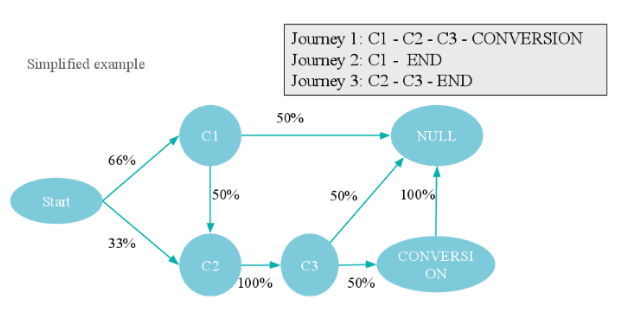It’s this ability to measure that’s setting great businesses apart from the rest nowadays. After all, how can you truly make strategic marketing decisions without fully understanding what’s working and what’s not?
Luckily we live in an era of high technology. Significant growth areas of tech, like Big Data, AI and Cloud have revolutionised the game when it comes to analytics and campaign reporting.
This means any digital marketing app or SaaS product worth its salt comes loaded with powerful analytics to help marketers justify the spend for their product and drive recurring revenues. But while this has made life easier for marketers in some ways, it’s created big problems in others.
Marketing teams across both B2C and B2B are using more of these services than ever. They’re blending dozens of tools together in the execution of a typical campaign and these tools go across many different channels, from events and experiential to social and community building.
Now we have the data deluge. So much data, in so many different places, it can often take the creation of an entire in-house team to figure out the return on marketing investment across campaign spend.
Enter attribution models
Attribution modelling came about to answer a lot of the problems marketers faced in this area. It provides a way for marketing teams to be able to measure meaningful interactions across the different channels they invest in. It provides an algorithmic method of being able to understand the relationship between different campaigns. So if someone had engaged with a paid Facebook campaign but went on to buy through responding on a Google AdWords re-targeting campaign, what credit should be given to the Facebook ad and what credit should be given to the Google re-targeting campaign?
Single Attribution
There are a number of different ways to execute these models for marketing across different channels. Every marketer you ask has a different opinion about the strengths and weaknesses of each approach. At this stage it’s worth exploring each one in turn and evaluating them on their merits (or otherwise).
Last Touch
Undoubtedly the most commonplace of all the different models of attribution, you’ll almost certainly have come across the Last Touch model in one of Google’s tools (AdWords or Analytics). It’s pretty straightforward. Basically, the last touchpoint gets the gold. The email that they clicked that led them to the landing page, the ad that they clicked on Google that took them to the product page – whatever the last meaningful campaign interaction was is credited with the conversion.
It’s commonplace because it’s easy. But for marketers operating multi-channel campaigns, which is the vast majority in today’s age, then it can often tell you surprisingly little about how your different tactics and campaigns are actually performing.
A Last Touch analysis tends to favour campaigns with stronger calls-to-action and also inevitably leans towards content and campaigns at the decision stage of the buyer’s journey. This sits counter to the inbound marketing methodology of creating campaign content that moves people through the process of attracting them to a website, subscribing them to content through great content offers and pushing the right blend of content in a way that helps them get the information they need to make a purchase.
First Touch
Another common attribution model is First Touch. In contrast to the Last Touch model, whichever campaign tactic was successful in engaging with the lead initially gets the recognition in ROI analysis. It suffers from similar problems to the Last Touch: it’s an overly-simplistic way of giving credit to the campaigns that are actually contributing to customer conversion. The First Touch method ignores all the interaction that a customer has had with the brand afterwards, some of which may have been extremely significant. Consider for a moment a strong holiday season sales promotions for a retail business. If it was actually a couple of months prior that a contact engaged with a campaign by signing up for a free competition, should this be given as much credit for creating the buyer? The same way Last Touch ignores the early part of the Buyer’s Journey, the First Touch method has a tendency to ignore the latter stages of the Buyer’s Journey – the decision content. There’s clearly going to be some very compelling campaigns operating here. This is the coalface of customer conversion and in many markets – very competitive markets – a single well-placed campaign can result in a huge upturn in sales.
What is Multi-touch Attribution?
Multi-Touch Attribution provides a clear way for multi-channel marketers to manage the problems posed by the single touch models of attribution. It accommodates the diversity that comes with trying to model attribution across the entire marketing mix and enables marketing professionals to get a much more in depth and meaningful analysis of how the different areas of their spend are contributing to the financial performance of their campaigns.
Multi-Touch Attribution is achieved by applying scoring to each campaign channel as part of an overall campaign effort. This scoring then ultimately provides a way of expressing the varying value that comes in deploying the different tactics and enables the right amount of credit to be given to the areas that are contributing the most value (whether financial or non financial).
Just as there are different Single Touch Attribution methods, there are different Multi Touch Attribution methods too. Let’s explore them in more detail.
Linear
The Linear model is slightly more advanced than the Single Touch methods in that it encompasses each of the touch points as part of a customer journey. So if a customer had entered a social media competition, clicked a link on a promotional newsletter and visited a website from a display ad – each would be given equal credit in measuring the return from the campaign conversion (a third of the value would go to each).
Time Decay
Time Decay is a neater multi-touch model and addresses the problems faced in First Touch attribution too.
It assigns progressively stronger weighting throughout the customer conversion process. That is, the 2nd touchpoint is weighted more strongly than the first, the 3rd more strongly to the 2nd and so on. The last customer touchpoint as part of that customer journey is considered the most important and is consequently more heavily weighted.
Stronger calls-to-action and more sales-oriented campaign tactics feature more prominently (and rightly so) later in the buyer’s journey than in the awareness stage.
Markov model
The Markov model of attribution establishes the mathematical probability of the steps a customer will take based on different sequencing scenarios.

This is determined by the Markov order:
- Order 0 – No understanding of the original location of the user or where they are in the journey
- Order 1 (Step A) The probability of the next move is calculated based on that position alone. It does not look at previous steps.
- Order 2 (Step B) – The likelihood of the next move based on current location and Step A.
- Order 3 (Step C) – …you get the picture.
After this we can get the contributing value of each touchpoint by programmatically simulating removal of each touchpoint and measuring how much that affects the total conversions.
This gives you the contributing value of each channel or campaign along the customer journey to make better marketing decisions.
Custom
If you’re into a spot of DIY, and don’t feel that any of the methods mentioned before fit your market or model in the right way, then there is another way. You can develop your own metrics, your own weighting system and construct the model that’s right for your specific circumstances.
It sounds appealing, but there are a few important points to note before you jump into custom attribution modelling. There’s no real ‘guide’ for doing this, no documented process you can follow. This can mean that just designing the model can end up as a really meaty consultancy project.
You would have to be comfortable with figuring it out as you go along, using agile methodologies to tweak and improve the model based on real time feedback from internal stakeholders.
Suffice to say, this is really something only larger companies with complex channel marketing approaches, lots of micro-conversion points and a marketing spend well into the millions should even consider doing. And even then, you need to be careful to not spend more on trying to get the data than is actually worthwhile. After all, spending too much extracting the right intelligence could end up negatively affecting the overall ROI of your marketing operations.
Which is right for my business?
There’s no one size fits all approach when it comes to attribution. That goes for Multi-Touch Attribution too. There’s no harm in experimenting with different models. Many organisations even find that running a couple of proof-of-concept projects with alternative attribution methods within the same time period can lead to interesting comparisons within the data. This can help to guide a decision on which method to focus on in the medium to long term.
